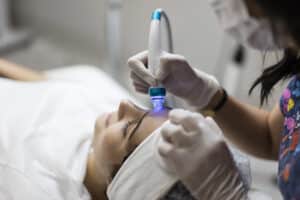What Is Microdermabrasion?
Microdermabrasion is a minimally invasive cosmetic procedure commonly used to rejuvenate the skin by gently exfoliating its outermost layer. It is a quick and effective way to improve the complexion and texture of skin, making it smoother and brighter. Microdermabrasion involves the use of a small handheld device to exfoliate the skin’s surface with a mild abrasive. The procedure is typically performed by a medical professional or technician, takes only 30-45 minutes, and requires no down time. Aside from minor redness that can occur post treatment, people can resume their regular activities the same day. It is important to keep in mind that the results may be temporary and subtle, but if you’re looking to improve your skin before an event, this is a great option.
For optimal results, this safe and effective procedure is best performed by a qualified medical professional specifically trained in performing microdermabrasion, such as a dermatologist, to ensure optimal results and minimize the risk of side effects.

What Is Microdermabrasion Used For?
Microdermabrasion is ideal for addressing minor skin imperfections. While it doesn’t eliminate flaws entirely, it helps blend them with the surrounding skin for a more even appearance. This treatment is often used to address:
- Blotchy skin discoloration.
- Age spots or sun damage.
- Fine lines and shallow scars.
- Acne or uneven skin texture.
It can be performed on various areas of the body, including the face, neck, chest, back, and hands. Several sessions (typically 4-6) spaced 2-4 weeks apart may be needed to achieve optimal results.
Who Should Avoid Microdermabrasion?
While microdermabrasion is suitable for many, it’s not recommended for everyone. Avoid this treatment if you:
- Have rosacea or prominent superficial blood vessels on your face, as it may worsen these conditions.
- Are taking isotretinoin (consult your doctor first).
- Have a mole or spot on the skin that’s bleeding, growing, or changing shape.
- Are prone to scarring such as keloids.
What to Prepare for Microdermabrasion?
To ensure the best results, follow these preparation tips:
- Discontinue retinoids and exfoliants: Stop using retinoids and harsh exfoliants at least 2 days before your treatment.
- Avoid blood thinners: If safe, stop taking nonessential blood-thinning medications or supplements 2 weeks before the procedure to reduce pinpoint bleeding. Always check with your medical professional before stopping any medication.
- Take measures to prevent cold sores: If your medical professional recommends you do so, take an antiviral medication, especially if you have a history of oral herpes simplex (cold sores) to prevent a flare-up.
- Stay hydrated: Drink plenty of water in the days leading up to your appointment to support your skin’s health.
What Should I Expect During the Microdermabrasion Procedure?
Here’s what you can expect during your microdermabrasion treatment:
- Preparation: You’ll lie down comfortably and your technician will provide protective eyewear to shield your eyes.
- Procedure: The handheld device will be brushed over your skin in gentle, circular motions. You might feel a mild scratching sensation, especially in sensitive areas like the temples or upper lip.
- Post-treatment cleaning: Any residual abrasive particles will be wiped off with a soft, wet washcloth.
The procedure is typically painless and well-tolerated.
Aftercare: What to Do Post-treatment
To maximize results and support healing:
- Cleanse and moisturize: Use a gentle cleanser followed by a hydrating moisturizer.
- Protect your skin from the sun: Avoid direct sunlight for 1-2 weeks and wear a broad-spectrum sunscreen (one that protects against UVA and UVB rays of SPF 30 or higher).
- Restart your skin care gradually: Once your redness subsides, you can resume topical treatments like retinoids, unless otherwise indicated by your medical professional.
- Stay alert: Contact your medical professional such as a dermatologist if you experience prolonged swelling, blisters, or signs of infection such as spreading redness or fever.
What Are the Risks and Side Effects?
Microdermabrasion is considered low risk, but minor side effects may include:
- Temporary redness and irritation.
- Mild skin discoloration (darkening or lightening), which resolves over time.
- Rarely, scarring.
These side effects usually subside within a few days.
Tips for Maximizing Results
- Combine microdermabrasion with a consistent skin-care routine, including moisturizers and serums tailored to your skin type.
- Avoid smoking, which can hinder your skin’s ability to heal and rejuvenate.
- Stay hydrated and eat a diet rich in skin-friendly nutrients like vitamins C and E.
FAQs About Microdermabrasion
Is microdermabrasion painful?
No, most people find the procedure painless, with only a mild scratching sensation.
How much does microdermabrasion cost?
Prices vary, but each session typically ranges from $75-$200.
Can I wear makeup after treatment?
It’s best to avoid makeup for at least 24 hours to allow your skin to heal.
Is microdermabrasion suitable for all skin tones?
Yes, this procedure is generally safe for all skin tones and types, although those with sensitive skin should consult a professional first.
Last modified on February 6th, 2025 at 12:33 pm